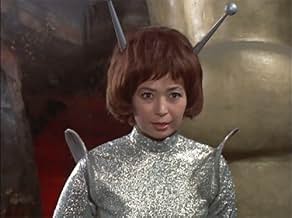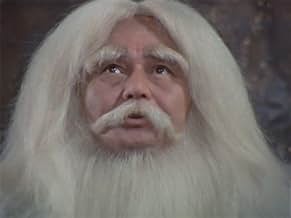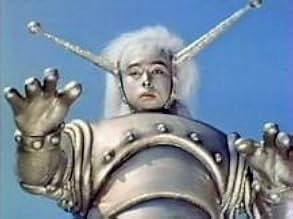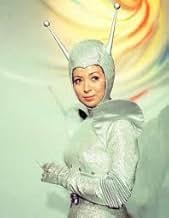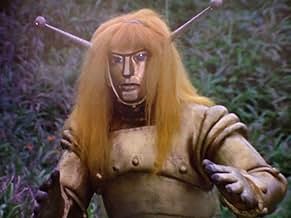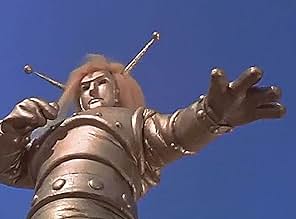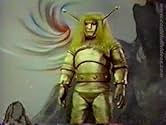O monstro Rodak vem conquistando planetas em todo o universo. Ele vê a Terra e a quer, pois é a melhor que já viu. Goldar e Silvar são enviados de outro planeta para proteger a Terra.O monstro Rodak vem conquistando planetas em todo o universo. Ele vê a Terra e a quer, pois é a melhor que já viu. Goldar e Silvar são enviados de outro planeta para proteger a Terra.O monstro Rodak vem conquistando planetas em todo o universo. Ele vê a Terra e a quer, pois é a melhor que já viu. Goldar e Silvar são enviados de outro planeta para proteger a Terra.
Explorar episódios
Enredo
Você sabia?
- CuriosidadesThis Japanese series can be viewed as a forerunner to the legendary "Transformers" franchise, which began in America in 1984 as a toy line but soon launched the hit Transformers (1984) and all subsequent TV series and feature films.
- ConexõesAlternate-language version of Vingadores do Espaço (1966)
Avaliação em destaque
Originally, I didn't want to make a fuss, but having seen this page again, and knowing this 'review' is what most people, who mayn't have any knowledge of this show, will be met with, each time they look up 'The Space Giants' I suddenly felt the strong need to respond.
I found 'Lone Solo's comments offensive, mean-spirited, and smarmy, but, worst of all, highly ill-informed. It seems as if the only exposure he's had to this programme was through the off-handed and unflattering trailer produced by WTBS in Atlanta during its run on that station in the 1970's.
Having gone back to watch it in my adult life, I, in addition to enjoying it immensely as a monster adventure series, was surprised at how clever and weighty it actually was. There's a point where the villain, Rodak, gets so desperate to control the Earth, that he actually takes up with organised crime to spread an highly addictive drug called 'Zenar'! I'd never noticed, there was a gradual progression from the light, frothy adventures, to a heavier, serious conflicts through the course of 'The Space Giants'. However, it was never heavy-handed or did it harm it as a children's adventure series. The series managed to remain true to its source and characters! I can't think of one example of a similar series, currently being produced for children, on America television, that compares.
The format of serialised adventures (four episodes for one story) was a budgetary decision that aided in story and character development. This also put it in sharp contrast with the other 'monster of the week' contemporaries of 'The Space Giants'. This, I felt, gave the heroes victories, defeats, struggles, and triumphs more gravitas. We feel the sorrow of Mikko and his father as, for several episodes (apparently months in the series context), Mikko's mother goes missing, kidnapped by Rodak.
'The Space Giants' also never pulled any punches when it came to death or violence, although, interestingly, it never reveled in them. (There is an instance, however, in the American dub, where a character, killed in the original Japanese show, is 'hospitalised' instead. Perhaps this was done because the character was a young girl and the producers felt it might upset children in the audience. I can't say for a certainty.) Given their approach to this area, the programme managed to never fall into the trap of callously showing violent acts or cheapening of human life as other series can tend to do. The monster battles were, at times very violent, but always on an 'operatic' scale.
As far as special effects are concerned, this is a very subjective topic. (I, for one, am not wild about cgi effects; among other things, they've never looked solid to me.) the effects produced for 'The Space Giants',as a whole, can only be described as hit or miss. They mayn't have always been special, but were certainly effective! What really helped was that they were always framed and edited well, not to mention highly imaginative. This in many ways, hid a lot of cost cutting. I'm afraid a modern similar series, wouldn't have half the ingenuity employed on 'The Space Giants' in this regard. (Again, this can be highly suggestive point, but if you have opportunity to see it, you'll see my argument.)
At the time, this was relatively untried territory for this type of programme. P Productions, the company that produced 'The Space Giants', had only previously made 'Agon The Atomic Dragon'. (I haven't seen this, although I hear it's surprisingly good. The monster suit from it does appear in 'The Space Giants' on two occasions.) 'Agon' was roughly a t. v. mini-series version of the original 'Godzilla'. However, it was having this under their belts, along with Tsuburaya Productions announcement of their new series 'Ultraman', that made 'P Pro' switch gears and produce 'The Space Giants' as a live action series.
Originally it was intended to produce a series similar the 'Astro Boy', another Osamu Tezuka creation. Previously animated sequences were actually re-tooled for use in the series. They are actually very effective.
These are just a few points, off the top of my head, about what I feel to be a cleverly handled series from the days before formula began to rule its genre.
I found 'Lone Solo's comments offensive, mean-spirited, and smarmy, but, worst of all, highly ill-informed. It seems as if the only exposure he's had to this programme was through the off-handed and unflattering trailer produced by WTBS in Atlanta during its run on that station in the 1970's.
Having gone back to watch it in my adult life, I, in addition to enjoying it immensely as a monster adventure series, was surprised at how clever and weighty it actually was. There's a point where the villain, Rodak, gets so desperate to control the Earth, that he actually takes up with organised crime to spread an highly addictive drug called 'Zenar'! I'd never noticed, there was a gradual progression from the light, frothy adventures, to a heavier, serious conflicts through the course of 'The Space Giants'. However, it was never heavy-handed or did it harm it as a children's adventure series. The series managed to remain true to its source and characters! I can't think of one example of a similar series, currently being produced for children, on America television, that compares.
The format of serialised adventures (four episodes for one story) was a budgetary decision that aided in story and character development. This also put it in sharp contrast with the other 'monster of the week' contemporaries of 'The Space Giants'. This, I felt, gave the heroes victories, defeats, struggles, and triumphs more gravitas. We feel the sorrow of Mikko and his father as, for several episodes (apparently months in the series context), Mikko's mother goes missing, kidnapped by Rodak.
'The Space Giants' also never pulled any punches when it came to death or violence, although, interestingly, it never reveled in them. (There is an instance, however, in the American dub, where a character, killed in the original Japanese show, is 'hospitalised' instead. Perhaps this was done because the character was a young girl and the producers felt it might upset children in the audience. I can't say for a certainty.) Given their approach to this area, the programme managed to never fall into the trap of callously showing violent acts or cheapening of human life as other series can tend to do. The monster battles were, at times very violent, but always on an 'operatic' scale.
As far as special effects are concerned, this is a very subjective topic. (I, for one, am not wild about cgi effects; among other things, they've never looked solid to me.) the effects produced for 'The Space Giants',as a whole, can only be described as hit or miss. They mayn't have always been special, but were certainly effective! What really helped was that they were always framed and edited well, not to mention highly imaginative. This in many ways, hid a lot of cost cutting. I'm afraid a modern similar series, wouldn't have half the ingenuity employed on 'The Space Giants' in this regard. (Again, this can be highly suggestive point, but if you have opportunity to see it, you'll see my argument.)
At the time, this was relatively untried territory for this type of programme. P Productions, the company that produced 'The Space Giants', had only previously made 'Agon The Atomic Dragon'. (I haven't seen this, although I hear it's surprisingly good. The monster suit from it does appear in 'The Space Giants' on two occasions.) 'Agon' was roughly a t. v. mini-series version of the original 'Godzilla'. However, it was having this under their belts, along with Tsuburaya Productions announcement of their new series 'Ultraman', that made 'P Pro' switch gears and produce 'The Space Giants' as a live action series.
Originally it was intended to produce a series similar the 'Astro Boy', another Osamu Tezuka creation. Previously animated sequences were actually re-tooled for use in the series. They are actually very effective.
These are just a few points, off the top of my head, about what I feel to be a cleverly handled series from the days before formula began to rule its genre.
- lcaustin2000
- 7 de set. de 2001
- Link permanente
Principais escolhas
Faça login para avaliar e ver a lista de recomendações personalizadas
- How many seasons does The Space Giants have?Fornecido pela Alexa
Detalhes
Contribua para esta página
Sugerir uma alteração ou adicionar conteúdo ausente

Principal brecha
By what name was The Space Giants (1966) officially released in Canada in English?
Responda
